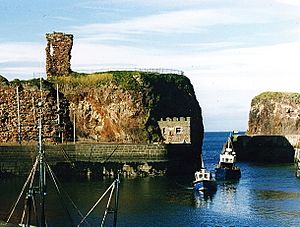John Muir Country Park facts for kids

The John Muir Country Park is a special nature area located near the village of West Barns. This village is close to the town of Dunbar in East Lothian, Scotland. The park is named after John Muir, a very famous naturalist and geologist. He was born in Dunbar and later moved to the United States, where he became well-known for his ideas about protecting nature.
This amazing park was officially created on 12 October 1976. It covers a huge area of about 713.5 hectares (that's over 1,760 acres!). The park stretches along 8 miles (about 13 kilometers) of beautiful coastline, from Pfeffer Sands all the way to Dunbar Castle. This area is super important for nature. It's part of the Firth of Forth Ramsar Site, which means it's a wetland of international importance. It's also a Site of Special Scientific Interest (SSSI) and a Special Protection Area (SPA). These titles mean the park is protected because it has unique plants, animals, and landscapes.
Contents
Amazing Wildlife in the Park
John Muir Country Park is home to many different types of natural areas. You can find woodlands, open grasslands, salty marshes, coastal sand dunes, and both rocky and sandy beaches. This mix of habitats means lots of different plants and animals can live here!
Plants and Flowers
The park is a plant paradise, with around 400 different kinds of plants recorded!
- In the saltmarsh, you'll often see thrift (Armeria maritima) and sea aster (Tripolium pannonicum). These plants love salty environments.
- On the upper parts of the beach, look for sea rocket (Cakile maritima) and biting stonecrop (Sedum acre).
- In the sand dunes, common plants include marram grass (Ammophila arenaria), which helps hold the dunes together, and birds-foot trefoil (Lotus corniculatus).
- Along the edges of the woodlands, you might spot pretty wildflowers like meadow cranesbill (Geranium pratense) and viper's bugloss (Echium vulgare).
Birds of the Park
The park is a fantastic place for birdwatching! You can see many different kinds of birds, including waterfowl, wading birds, gulls, and terns.
- Some birds live here all year round, like the elegant whooper swan and the common greenshank.
- Other birds are migrants, meaning they visit the park during certain seasons. These include the Eurasian whimbrel and the tiny little tern.
- In the woodlands and grasslands, you might spot a common crossbill, a bright green green woodpecker, or a clever Eurasian jay.
- You could also see a European stonechat perched on a bush or hear the beautiful song of a Eurasian skylark high above the fields.
- Sometimes, rare birds even make a stop here, like the American black duck or the green heron.
Other Fascinating Creatures
Beyond birds, the park is buzzing with other interesting wildlife.
- Two of the most common butterflies you'll see fluttering around are the meadow brown and the bright common blue.
- Keep an eye out for day-flying moths too! The striking cinnabar moth and the six-spot burnet moth are often seen during the day.
History and Old Structures
John Muir Country Park isn't just about nature; it's also full of history! There are 52 different historical and archaeological sites within the park's boundaries. These include old ruins, buildings, monuments, wartime defenses, and even shipwrecks.
Dunbar Castle's Story
The ancient ruins of Dunbar Castle are located right within the park. This castle was once one of the most important buildings in Scotland for defending the country. It was involved in many battles as different groups, like the Picts and Angles, fought to control it and the surrounding area.
Even after Scotland and England became peaceful, the castle ruins made news again in 1842. This was when electrically fired demolition charges were used for the very first time in a practical way! They were used to blast a channel through the rock, creating an entrance for the new Victoria Harbour.
Since 1567, the castle has slowly been falling apart due to waves and weather. Big parts of its walls collapsed in 1868 and 1993, and smaller pieces are lost every year. Today, you can't visit the castle ruins up close for safety reasons.


